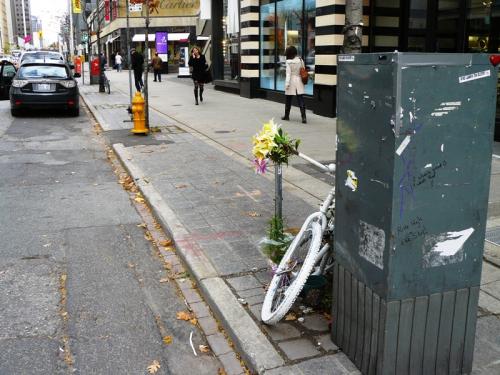 csara 31 weeks pregnant
csara 31 weeks pregnant
(Photo: jonnyhunter)
The Walrus' Emily Testa investigates Toronto's plan to implement a public bikesharing system, trying to see if bikesharing will help calm the "war on cars".
Walk a block in Toronto’s downtown core on any weekday afternoon, and you’ll see the strain of cyclist-motorist relations from the belly of the beast. Drivers roll their eyes and drum their fingers, and many cyclists ignore red lights and stop signs as traffic allows. At its worst, the drama plays out with fatal consequences, as it did in late August, when a downtown road altercation involving former Ontario attorney general Michael Bryant, who was driving a convertible car, caused the death of bicycle courier Darcy Allan Sheppard. Toronto cyclists rallied for bike lanes in the wake of the incident, insisting that separate roadways guarantee safer transit, especially in regions where traffic is busiest. Drivers and business owners, however, have been less willing to accept bike lanes as the solution, citing slow commutes and limited street parking, respectively, as evidence that city roadways have already been compromised enough. So with cyclists getting killed and drivers getting angry, what’s a judicious citizen to believe? Can’t we all just get along?
The answer seems to be no, but perhaps a Toronto BIXI system will either lessen the conflict or increase it. What will it be?
Toronto’s updated plan, modeled after Montreal’s two-year old BIXI and the 20,000–strong Vélib “shared bicycle” program in Paris, proposes a start-up service area bounded by High Park in the west, Broadview Avenue in the east, Bloor Street in the north and Lake Ontario to the south. The projected system — roughly 300 rental stations with an initial capacity of 1,000 bicycles [correction: 3000 bicycles initially], to be increased to 10,000 over the next decade — will inevitably place a greater number of commuters on some of the city’s busiest roads. As a public transportation venture, a bicycle system presents a unique safety imperative. But are bike lanes the solution? Beyond their formidable logistic and financial considerations, would separate lanes ease the competing interests of cyclists and motorists?
It's not a given that increased numbers of cyclists will increase conflicts at the same rate. It is offset by the fact that motorists become used to cyclists on the road and take preventative measures (the concept is "safety in numbers"). Lanes have been shown to make a difference, however, and this is a basic principle in the Bike Plan. It's unclear, then why Councillor Adrian Heaps states: “Putting a bucket of paint on the road doesn’t make a safer bike corridor. It comes down to mutual respect.” Does this mean that Heaps doesn't really believe in that part of the Bike Plan?
Christopher Sumpton (who produced the documentary Pedal Power on CBC) sees bikesharing as helping to create a cultural shift.
He says the “dramatic immediate effect” of a public bicycle system will be a societal awareness of cycling, a “push to the process of mental change that bikes are a serious part of the transit system.” Moreover, he says, more bicycles and less cars in the downtown core will improve the quality of street life; Torontonians will experience “more human interaction, with people able to stop at shops and cafés instead of going by in a bus or car.”
Finally, Richard Poplak, writer for Toronto Life and elsewhere, is given his chances to weigh in, concluding that people don't need bike lanes, nor bikesharing. Again a journalist equates an uber-cyclist racing type as being an all around expert on transportation. It's no problem for a cyclist who can average 30 to 40 km/hr in city traffic to ride in a "vehicular" style, and probably sees all bike lanes as only encouraging slow grandmothers to bike in his way. He probably sees no point to bike parking either since his bike is too expensive to lock up outside anyway.
“What bike lanes don’t do is enshrine cycling as a right,” he says. “What they do do, is enshrine the primacy of the car.”
By that logic, Copenhagen would be headquarters of the car empire, which, just to clarify, it is not. What bike lanes do is recognize cyclists as being unique road users and that they need to considered in road design just as cars are considered.
Believe it or not, Poplak is in the minority now among cyclists and planners. You won't find too many people outside of a outspoken few (followers of John Forester) who believe that bike lanes are useless and that all we need is better education. Not even Toronto's planners and CAN-BIKE instructors believe that education and better enforcement is going to solve things on their own. The Bike Plan puts education as only one of the four areas, and a large portion of the money is being spent on improving the roadways to better accommodate the unique needs of cyclists, whether it is through bike lanes, bike signal lights, advanced stop boxes, painted "sharrows" to encourage drivers to give cyclists room, and so on.
The truth is that very, very few people are as fast or capable as Poplak on a bike, so why would we plan our streets for only Poplak when our societal goal is to get ordinary people comfortably and safely on bikes?
Bikesharing will bring a lot of new people onto the roads. It's going to be messy and some people will get hurt before they learn to navigate in traffic better (both drivers and cyclists). But having more bikes on the road will help push a cultural shift that will be more important in increasing cyclist safety than any one individual taking a "vehicular" cycling approach.

